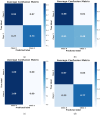Interpretable Machine Learning for Osteopenia Detection: A Proof-of-Concept Study Using Bioelectrical Impedance in Perimenopausal Women
- PMID: 40700198
- PMCID: PMC12286257
- DOI: 10.3390/jfmk10030262
Interpretable Machine Learning for Osteopenia Detection: A Proof-of-Concept Study Using Bioelectrical Impedance in Perimenopausal Women
Abstract
Objectives: The early detection of low bone mineral density (BMD) is essential for preventing osteoporosis and related complications. While dual-energy X-ray absorptiometry (DXA) remains the gold standard for diagnosis, its cost and limited availability restrict its use in large-scale screening. This study investigated whether raw bioelectrical impedance analysis (BIA) data combined with explainable machine learning (ML) models could accurately classify osteopenia in women aged 40 to 55. Methods: In a cross-sectional design, 138 women underwent same-day BIA and DXA assessments. Participants were categorized as osteopenic (T-score between -1.0 and -2.5; n = 33) or normal (T-score ≥ -1.0) based on DXA results. Overall, 24.1% of the sample were classified as osteopenic, and 32.85% were postmenopausal. Raw BIA outputs were used as input features, including impedance values, phase angles, and segmental tissue parameters. A sequential forward feature selection (SFFS) algorithm was employed to optimize input dimensionality. Four ML classifiers were trained using stratified five-fold cross-validation, and SHapley Additive exPlanations (SHAP) were applied to interpret feature contributions. Results: The neural network (NN) model achieved the highest classification accuracy (92.12%) using 34 selected features, including raw impedance measurements, derived body composition indices such as regional lean mass estimates and the edema index, as well as a limited number of categorical variables, including self-reported physical activity status. SHAP analysis identified muscle mass indices and fluid distribution metrics, features previously associated with bone health, as the most influential predictors in the current model. Other classifiers performed comparably but with lower precision or interpretability. Conclusions: ML models based on raw BIA data can classify osteopenia with high accuracy and clinical transparency. This approach provides a cost-effective and interpretable alternative for the early identification of individuals at risk for low BMD in resource-limited or primary care settings.
Keywords: perimenopause; preventive medicine; public health screening.
Conflict of interest statement
The authors declare no conflicts of interest.
Figures



Similar articles
-
Bioelectrical impedance analysis of bone mineral content based on dual-energy X-ray absorptiometry: evaluation of age-stratified optimized models.Sci Rep. 2025 Jul 9;15(1):24658. doi: 10.1038/s41598-025-08304-8. Sci Rep. 2025. PMID: 40634401 Free PMC article.
-
Segmental fat-free mass and lean soft mass: a comparative study with dual X-ray absorptiometry (DXA), bioelectrical impedance analysis (BIA) and anthropometry and development of anthropometric prediction models.J Int Soc Sports Nutr. 2025 Dec;22(1):2542368. doi: 10.1080/15502783.2025.2542368. Epub 2025 Aug 5. J Int Soc Sports Nutr. 2025. PMID: 40762907 Free PMC article.
-
Cost-effectiveness of using prognostic information to select women with breast cancer for adjuvant systemic therapy.Health Technol Assess. 2006 Sep;10(34):iii-iv, ix-xi, 1-204. doi: 10.3310/hta10340. Health Technol Assess. 2006. PMID: 16959170
-
Machine learning-driven clinical decision support for low bone mineral density: A web-based prediction model with explainable AI integration.Bone. 2025 Jul 15;200:117592. doi: 10.1016/j.bone.2025.117592. Online ahead of print. Bone. 2025. PMID: 40669588
-
Signs and symptoms to determine if a patient presenting in primary care or hospital outpatient settings has COVID-19.Cochrane Database Syst Rev. 2022 May 20;5(5):CD013665. doi: 10.1002/14651858.CD013665.pub3. Cochrane Database Syst Rev. 2022. PMID: 35593186 Free PMC article.
References
LinkOut - more resources
Full Text Sources

